Intranasal Immunization with a Recombinant Adenovirus Encoding Multi-Stage Antigens of Mycobacterium tuberculosis Preferentially Elicited CD8+ T Cell Immunity and Conferred a Superior Protection in the Lungs of Mice than Bacillus Calmette–Guerin
Abstract
:1. Introduction
2. Materials and Methods
2.1. Mice
2.2. Cells and Mycobacteria
2.3. Recombinant Adenovirus Ad-AE-R2
2.4. Recombinant AE and R2 Fusion Proteins
3. BCG Subcutaneous Immunization and Intranasal Immunization of Ad-AE-R2
3.1. Immunogenicity Studies in Mice
3.2. Secretory IgA (sIgA) Measurement in BALF
3.3. Identification of Antibodies Specific to Antigens in Serum
3.4. Preparation of Single-Cell Suspensions
3.5. Lymphocyte Proliferation Assay
3.6. Cell Surface Staining
3.7. Intracellular Cytokine Staining and Flow Cytometry Analysis
3.8. Intratracheal BCG Challenge
3.9. Enumeration of Bacterial Burden in Organs
3.10. Statistics
4. Results
4.1. Characteristics of the Recombinant Adenovirus Ad-AE-R2 Expressing Mtb Multi-Stage Antigens
4.2. Intranasal Immunization with Ad-AE-R2 Preferentially Induces the Accumulation of CD8+ T Cells in the Airway and Facilitates the Generation of CD8+ TRM Cells
4.3. Intranasal Immunization with Ad-AE-R2 Selectively Amplifies the Proportion of CD8+ T Cells in the Lung of Immunized Mice While Also Inducing a Higher Proportion of CD8+ T Cells That Produce Cytokines Compared to BCG
4.4. Intranasal Immunization with Ad-AE-R2 Selectively Enhances the Proportions of CD8+ T Cells and Induces the Generation of Tem and Tcm Cells in the Spleen of Mice
4.5. Intranasal Immunization with Ad-AE-R2 Could Rapidly Induce Th1-Biased Humoral Immune Responses
4.6. Intranasal Immunization with Ad-AE-R2 Could Confer Superior Protection in the Lung of Mice Compared to BCG
5. Discussion
Supplementary Materials
Author Contributions
Funding
Institutional Review Board Statement
Informed Consent Statement
Data Availability Statement
Acknowledgments
Conflicts of Interest
References
- Global Tuberculosis Report 2023. Available online: https://www.who.int/publications/i/item/9789240083851 (accessed on 7 November 2023).
- Ahmed, A.; Rakshit, S.; Adiga, V.; Dias, M.; Dwarkanath, P.; D’Souza, G.; Vyakarnam, A. A century of BCG: Impact on tuberculosis control and beyond. Immunol. Rev. 2021, 301, 98–121. [Google Scholar] [CrossRef]
- Fatima, S.; Kumari, A.; Das, G.; Dwivedi, V.P. Tuberculosis vaccine: A journey from BCG to present. Life Sci. 2020, 252, 117594. [Google Scholar] [CrossRef] [PubMed]
- Afkhami, S.; Yao, Y.; Xing, Z. Methods and clinical development of adenovirus-vectored vaccines against mucosal pathogens. Mol. Ther.-Methods Clin. Dev. 2016, 3, 16030. [Google Scholar] [CrossRef] [PubMed]
- Gebre, M.S.; Brito, L.A.; Tostanoski, L.H.; Edwards, D.K.; Carfi, A.; Barouch, D.H. Novel approaches for vaccine development. Cell 2021, 184, 1589–1603. [Google Scholar] [CrossRef] [PubMed]
- Zhu, F.-C.; Li, Y.-H.; Guan, X.-H.; Hou, L.-H.; Wang, W.-J.; Li, J.-X.; Wu, S.-P.; Wang, B.-S.; Wang, Z.; Wang, L.; et al. Safety, tolerability, and immunogenicity of a recombinant adenovirus type-5 vectored COVID-19 vaccine: A dose-escalation, open-label, non-randomised, first-in-human trial. Lancet 2020, 395, 1845–1854. [Google Scholar] [CrossRef]
- Wang, J.; Thorson, L.; Stokes, R.W.; Santosuosso, M.; Huygen, K.; Zganiacz, A.; Hitt, M.; Xing, Z. Single mucosal, but not parenteral, immunization with recombinant adenoviral-based vaccine provides potent protection from pulmonary tuberculosis. J. Immunol. 2004, 173, 6357–6365. [Google Scholar] [CrossRef]
- Jeyanathan, M.; Fritz, D.K.; Afkhami, S.; Aguirre, E.; Howie, K.J.; Zganiacz, A.; Dvorkin-Gheva, A.; Thompson, M.R.; Silver, R.F.; Cusack, R.P.; et al. Aerosol delivery, but not intramuscular injection, of adenovirus-vectored tuberculosis vaccine induces respiratory- mucosal immunity in humans. JCI Insight 2022, 7, e155655. [Google Scholar] [CrossRef]
- Voskuil, M.I.; Schnappinger, D.; Visconti, K.C.; Harrell, M.I.; Dolganov, G.M.; Sherman, D.R.; Schoolnik, G.K. Inhibition of respiration by nitric oxide induces a Mycobacterium tuberculosis dormancy program. J. Exp. Med. 2003, 198, 705–713. [Google Scholar] [CrossRef]
- Lin, M.Y.; Ottenhoff, T.H. Host-pathogen interactions in latent Mycobacterium tuberculosis infection: Identification of new targets for tuberculosis intervention. Endocr. Metab. Immune Disord.-Drug Targets 2008, 8, 15–29. [Google Scholar] [CrossRef]
- Roupie, V.; Romano, M.; Zhang, L.; Korf, H.; Lin, M.Y.; Franken, K.L.M.C.; Ottenhoff, T.H.M.; Klein, M.R.; Huygen, K. Immunogenicity of eight dormancy regulon-encoded proteins of Mycobacterium tuberculosis in DNA-vaccinated and tuberculosis-infected mice. Infect. Immun. 2007, 75, 941–949. [Google Scholar] [CrossRef]
- Avarvand, A.Y.; Khademi, F.; Tafaghodi, M.; Ahmadipour, Z.; Moradi, B.; Meshkat, Z. The roles of latency-associated antigens in tuberculosis vaccines. Indian J. Tuberc. 2019, 66, 487–491. [Google Scholar] [CrossRef] [PubMed]
- Andersen, P. Vaccine strategies against latent tuberculosis infection. Trends Microbiol. 2007, 15, 7–13. [Google Scholar] [CrossRef] [PubMed]
- Wang, L.M.; Jiang, H.; Kang, J.; Jin, Q.Q. Construction and identification of a recombinanted adenovirus encoding fusion proteins of multi-stage antigens of Mycobacterium tuberculosis. Chin. J. Zoonoses 2022, 38, 191–195. [Google Scholar]
- Shi, C.H.; Fan, X.L.; Xu, Z.K.; Li, Y.; Bai, Y.L. Expression and purification of the fusion protein Ag85B-ESAT6 from Mycobacterium tuberculosis. Chin. J. Tuberc. Respir. Dis. 2004, 27, 89–92. [Google Scholar] [CrossRef]
- Wakeham, J.; Wang, J.; Magram, J.; Croitoru, K.; Harkness, R.; Dunn, P.; Zganiacz, A.; Xing, Z. Lack of both types 1 and 2 cytokines, tissue inflammatory responses, and immune protection during pulmonary infection by Mycobacterium bovis bacille Calmette-Guérin in IL-12-deficient mice. J. Immunol. 1998, 160, 6101–6111. [Google Scholar] [CrossRef] [PubMed]
- Li, W.; Deng, G.; Li, M.; Zeng, J.; Zhao, L.; Liu, X.; Wang, Y. A recombinant adenovirus expressing CFP10, ESAT6, Ag85A and Ag85B of Mycobacterium tuberculosis elicits strong antigen-specific immune responses in mice. Mol. Immunol. 2014, 62, 86–95. [Google Scholar] [CrossRef]
- D’Agostino, M.R.; Lai, R.; Afkhami, S.; Khera, A.; Yao, Y.; Vaseghi-Shanjani, M.; Zganiacz, A.; Jeyanathan, M.; Xing, Z. Airway macrophages mediate mucosal vaccine-induced trained innate immunity against Mycobacterium tuberculosis in early stages of infection. J. Immunol. 2020, 205, 2750–2762. [Google Scholar] [CrossRef]
- Cheuk, S.; Schlums, H.; Sérézal, I.G.; Martini, E.; Chiang, S.C.; Marquardt, N.; Gibbs, A.; Detlofsson, E.; Introini, A.; Forkel, M.; et al. CD49a expression defines tissue-resident CD8+ T cells poised for cytotoxic function in human skin. Immunity 2017, 46, 287–300. [Google Scholar] [CrossRef]
- Ogongo, P.; Porterfield, J.Z.; Leslie, A. Lung tissue resident memory T-cells in the immune response to Mycobacterium tuberculosis. Front Immunol. 2019, 10, 992. [Google Scholar] [CrossRef]
- Gregory, A.E.; van Schaik, E.J.; Russell-Lodrigue, K.E.; Fratzke, A.P.; Samuel, J.E. Coxiella burnetii intratracheal aerosol infection model in mice, guinea pigs, and nonhuman primates. Infect. Immun. 2019, 87, e00178-19. [Google Scholar] [CrossRef]
- Lai, R.; Afkhami, S.; Haddadi, S.; Jeyanathan, M.; Xing, Z. Mucosal immunity and novel tuberculosis vaccine strategies: Route of immunisation-determined T-cell homing to restricted lung mucosal compartments. Eur. Respir. Rev. 2015, 24, 356–360. [Google Scholar] [CrossRef]
- Li, Y.; Jin, L.; Chen, T. The effects of secretory IgA in the mucosal immune system. Biomed Res. Int. 2020, 2020, 2032057. [Google Scholar] [CrossRef]
- Mueller, S.N.; Mackay, L.K. Tissue-resident memory T cells: Local specialists in immune defence. Nat. Rev. Immunol. 2016, 16, 79–89. [Google Scholar] [CrossRef]
- Beverley, P.C.L.; Sridhar, S.; Lalvani, A.; Tchilian, E.Z. Harnessing local and systemic immunity for vaccines against tuberculosis. Mucosal Immunol. 2014, 7, 20–26. [Google Scholar] [CrossRef] [PubMed]
- Dong, C. Cytokine regulation and function in T cells. Annu. Rev. Immunol. 2021, 39, 51–76. [Google Scholar] [CrossRef]
- Kaech, S.M.; Wherry, E.J.; Ahmed, R. Effector and memory T-cell differentiation: Implications for vaccine development. Nat. Rev. Immunol. 2002, 2, 251–262. [Google Scholar] [CrossRef] [PubMed]
- Casadevall, A. To be or not be a (functional) antibody against TB. Cell 2016, 167, 306–307. [Google Scholar] [CrossRef]
- Lu, L.L.; Chung, A.W.; Rosebrock, T.R.; Ghebremichael, M.; Yu, W.H.; Grace, P.S.; Schoen, M.K.; Tafesse, F.; Martin, C.; Leung, V.; et al. A functional role for antibodies in tuberculosis. Cell 2016, 167, 433–443. [Google Scholar] [CrossRef] [PubMed]
- Pulendran, B.; Ahmed, R. Immunological mechanisms of vaccination. Nat. Immunol. 2011, 12, 509–517. [Google Scholar] [CrossRef]
- Brisse, M.; Vrba, S.M.; Kirk, N.; Liang, Y.; Ly, H. Emerging concepts and technologies in vaccine development. Front. Immunol. 2020, 11, 583077. [Google Scholar] [CrossRef]
- Stylianou, E.; Paul, M.J.; Reljic, R.; McShane, H. Mucosal delivery of tuberculosis vaccines: A review of current approaches and challenges. Expert Rev. Vaccines 2019, 18, 1271–1284. [Google Scholar] [CrossRef]
- Li, M.; Wang, Y.; Sun, Y.; Cui, H.; Zhu, S.J.; Qiu, H.-J. Mucosal vaccines: Strategies and challenges. Immunol. Lett. 2020, 217, 116–125. [Google Scholar] [CrossRef] [PubMed]
- Deng, G.; Li, W.; Wu, X.; Bao, S.; Zeng, J.; Zhao, N.; Luo, M.; Liu, X.; Wang, Y. Immunogenicity and protective efficacy of a recombinant adenoviral based vaccine expressing heat-stable enterotoxin (STa) and K99 adhesion antigen of enterotoxigenic Escherichia coli in mice. Mol. Immunol. 2015, 68 Pt 2, 684–691. [Google Scholar] [CrossRef] [PubMed]
- Maddaloni, M.; Staats, H.F.; Mierzejewska, D.; Hoyt, T.; Robinson, A.; Callis, G.; Kozaki, S.; Kiyono, H.; McGhee, J.R.; Fujihashi, K.; et al. Mucosal vaccine targeting improves onset of mucosal and systemic immunity to botulinum neurotoxin A. J. Immunol. 2006, 177, 5524–5532. [Google Scholar] [CrossRef]
- Braciak, T.A.; Gallichan, W.S.; Graham, F.L.; Richards, C.D.; Ramsay, A.J.; Rosenthal, K.L.; Gauldie, J. Recombinant adenovirus vectors expressing interleukin-5 and -6 specifically enhance mucosal immunoglobulin A responses in the lung. Immunology 2000, 101, 388–396. [Google Scholar] [CrossRef]
- Greenbaum, E.; Furst, A.; Kiderman, A.; Stewart, B.; Levy, R.; Schlesinger, M.; Morag, A.; Zakay-Rones, Z. Mucosal [SIgA] and serum [IgG] immunologic responses in the community after a single intra-nasal immunization with a new inactivated trivalent influenza vaccine. Vaccine 2002, 20, 1232–1239. [Google Scholar] [CrossRef]
- Chen, T.; Blanc, C.; Liu, Y.; Ishida, E.; Singer, S.; Xu, J.; Joe, M.; Jenny-Avital, E.R.; Chan, J.; Lowary, T.L.; et al. Capsular glycan recognition provides antibody-mediated immunity against tuberculosis. J. Clin. Investig. 2020, 130, 1808–1822. [Google Scholar] [CrossRef] [PubMed]
- Chen, T.; Blanc, C.; Eder, A.Z.; Prados-Rosales, R.; Souza, A.C.O.; Kim, R.S.; Glatman-Freedman, A.; Joe, M.; Bai, Y.; Lowary, T.L.; et al. Association of human antibodies to arabinomannan with enhanced Mycobacterial opsonophagocytosis and intracellular growth reduction. J. Infect. Dis. 2016, 214, 300–310. [Google Scholar] [CrossRef]
- Qu, M.; Zhou, X.; Li, H. BCG vaccination strategies against tuberculosis: Updates and perspectives. Hum. Vaccines Immunother. 2021, 17, 5284–5295. [Google Scholar] [CrossRef]
- Horvath, C.N.; Shaler, C.R.; Jeyanathan, M.; Zganiacz, A.; Xing, Z. Mechanisms of delayed anti-tuberculosis protection in the lung of parenteral BCG-vaccinated hosts: A critical role of airway luminal T cells. Mucosal Immunol. 2012, 5, 420–431. [Google Scholar] [CrossRef]
- Santosuosso, M.; Zhang, X.; McCormick, S.; Wang, J.; Hitt, M.; Xing, Z. Mechanisms of mucosal and parenteral tuberculosis vaccinations: Adenoviral-based mucosal immunization preferentially elicits sustained accumulation of immune protective CD4 and CD8 T cells within the airway lumen. J. Immunol. 2005, 174, 7986–7994. [Google Scholar] [CrossRef] [PubMed]
- Darrah, P.A.; Zeppa, J.J.; Wang, C.; Irvine, E.B.; Bucsan, A.N.; Rodgers, M.A.; Pokkali, S.; Hackney, J.A.; Kamath, M.; White, A.G.; et al. Airway T cells are a correlate of i.v. Bacille Calmette-Guerin-mediated protection against tuberculosis in rhesus macaques. Cell Host Microbe 2023, 31, 962–977.e8. [Google Scholar] [CrossRef]
- Behar, S.M.; Woodworth, J.S.; Wu, Y. Next generation: Tuberculosis vaccines that elicit protective CD8+ T cells. Expert Rev. Vaccines 2007, 6, 441–456. [Google Scholar] [CrossRef]
- Scriba, T.J.; Netea, M.G.; Ginsberg, A.M. Key recent advances in TB vaccine development and understanding of protective immune responses against Mycobacterium tuberculosis. Semin. Immunol. 2020, 50, 101431. [Google Scholar] [CrossRef] [PubMed]
- Lin, P.L.; Flynn, J.L. CD8 T cells and Mycobacterium tuberculosis infection. Semin. Immunopathol. 2015, 37, 239–249. [Google Scholar] [CrossRef]
- Winchell, C.G.; Nyquist, S.K.; Chao, M.C.; Maiello, P.; Myers, A.J.; Hopkins, F.; Gideon, H.P.; Patel, K.V.; Bromley, J.D.; Simonson, A.W.; et al. CD8+ lymphocytes are critical for early control of tuberculosis in macaques. J. Exp. Med. 2023, 220, e20230707. [Google Scholar] [CrossRef]
- Alexandre, Y.O.; Mueller, S.N. Splenic stromal niches in homeostasis and immunity. Nat. Rev. Immunol. 2023, 23, 705–719. [Google Scholar] [CrossRef]
- Biffar, L.; Blunt, L.; Atkins, W.; Anderson, P.; Holder, T.; Xing, Z.; Vordermeier, M.; McShane, H.; Villarreal-Ramos, B. Evaluating the sensitivity of the bovine BCG challenge model using a prime boost Ad85A vaccine regimen. Vaccine 2020, 38, 1241–1248. [Google Scholar] [CrossRef]
- Gonzalez-Juarrero, M.; Bosco-Lauth, A.; Podell, B.; Soffler, C.; Brooks, E.; Izzo, A.; Sanchez-Campillo, J.; Bowen, R. Experimental aerosol Mycobacterium bovis model of infection in goats. Tuberculosis 2013, 93, 558–564. [Google Scholar] [CrossRef]
- Villarreal-Ramos, B.; Berg, S.; Chamberlain, L.; McShane, H.; Hewinson, R.G.; Clifford, D.; Vordermeier, M. Development of a BCG challenge model for the testing of vaccine candidates against tuberculosis in cattle. Vaccine 2014, 32, 5645–5649. [Google Scholar] [CrossRef] [PubMed]
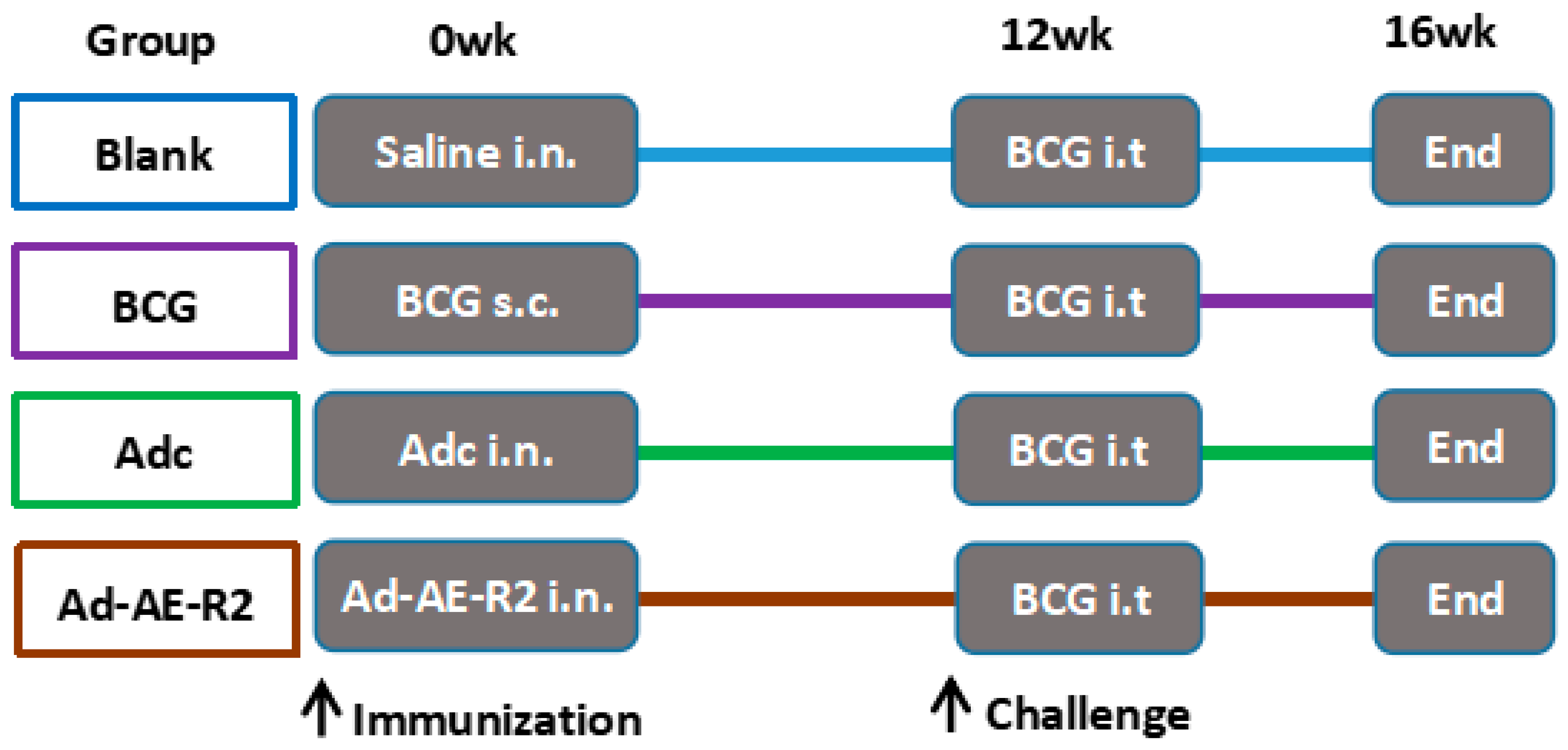
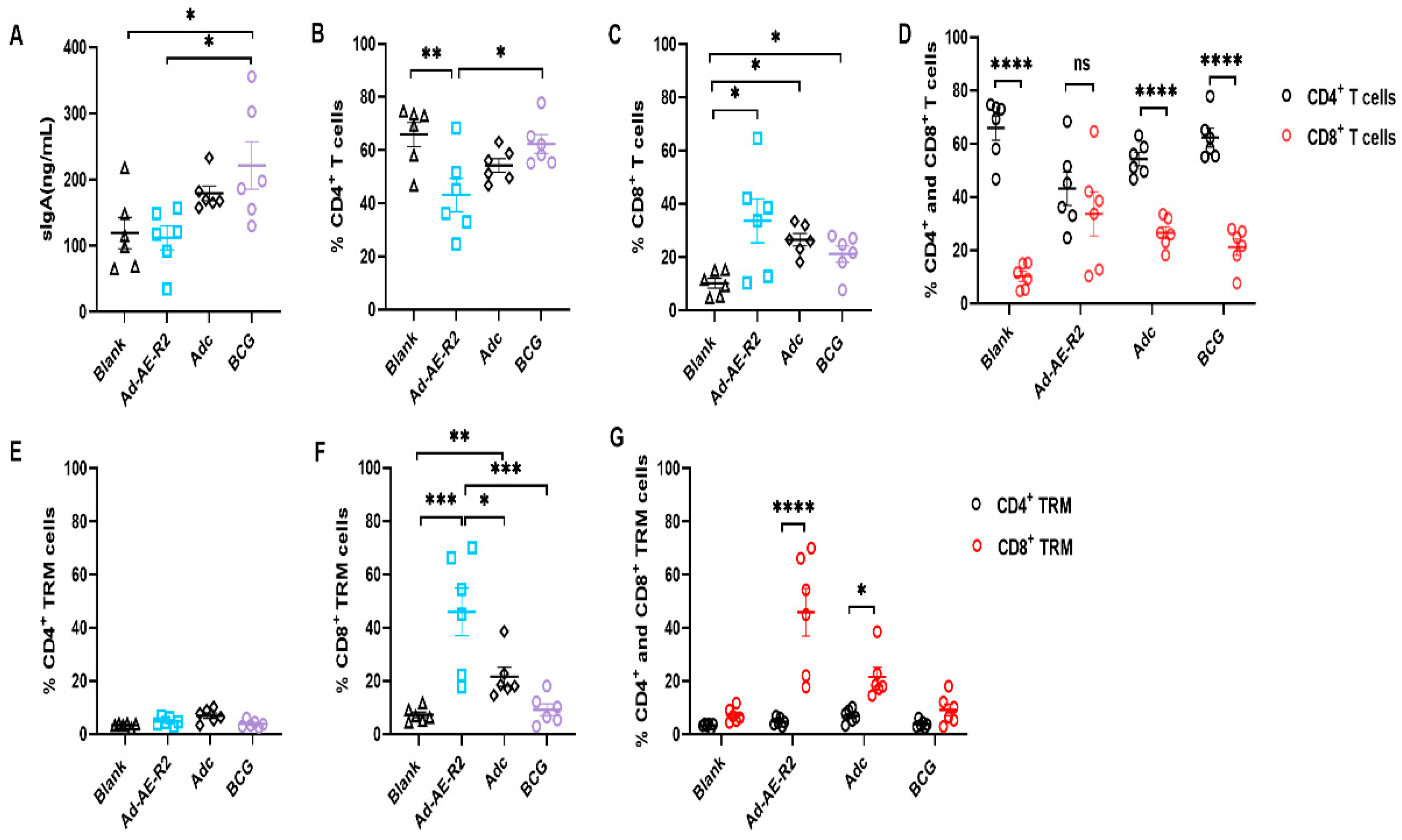
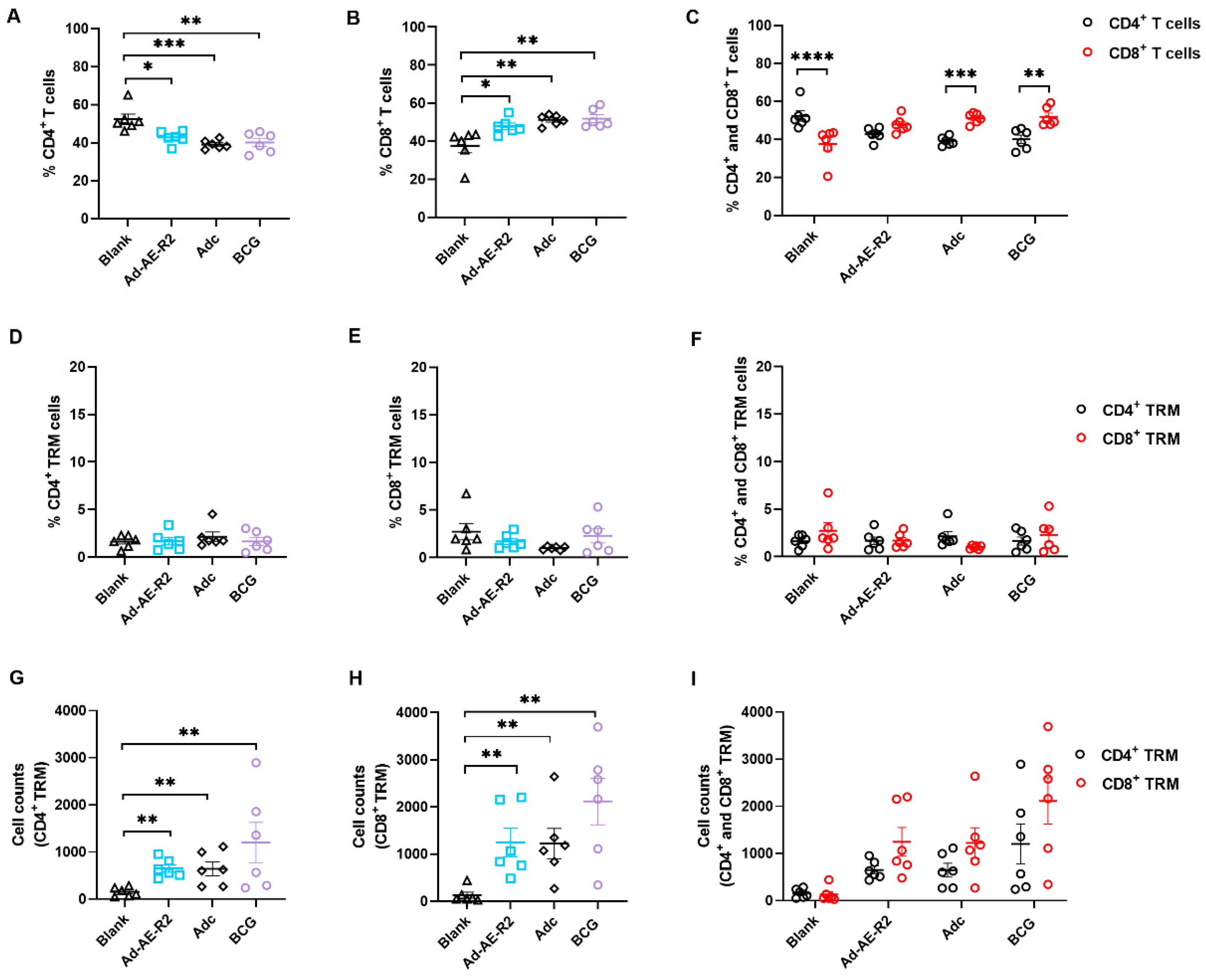
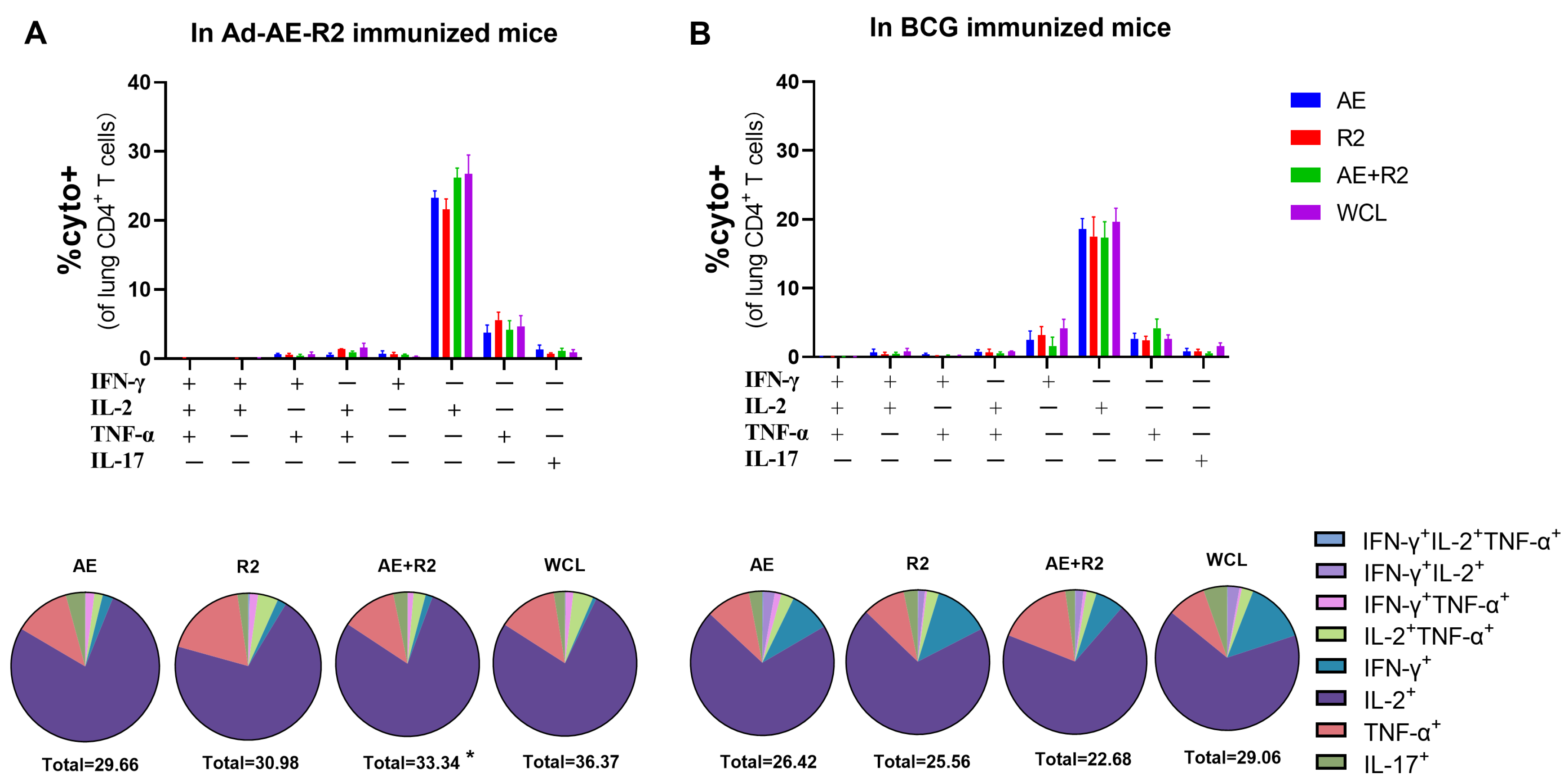
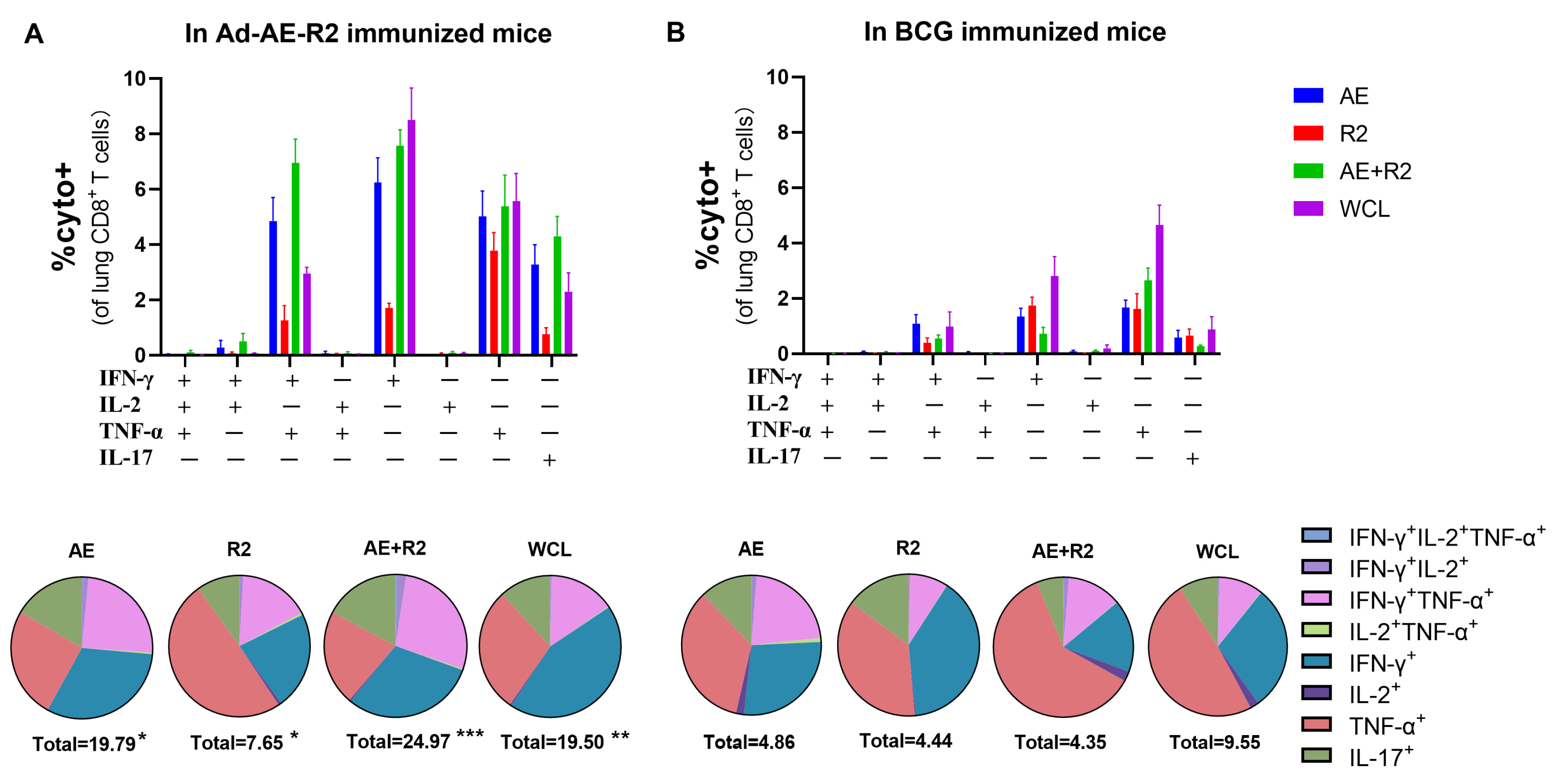
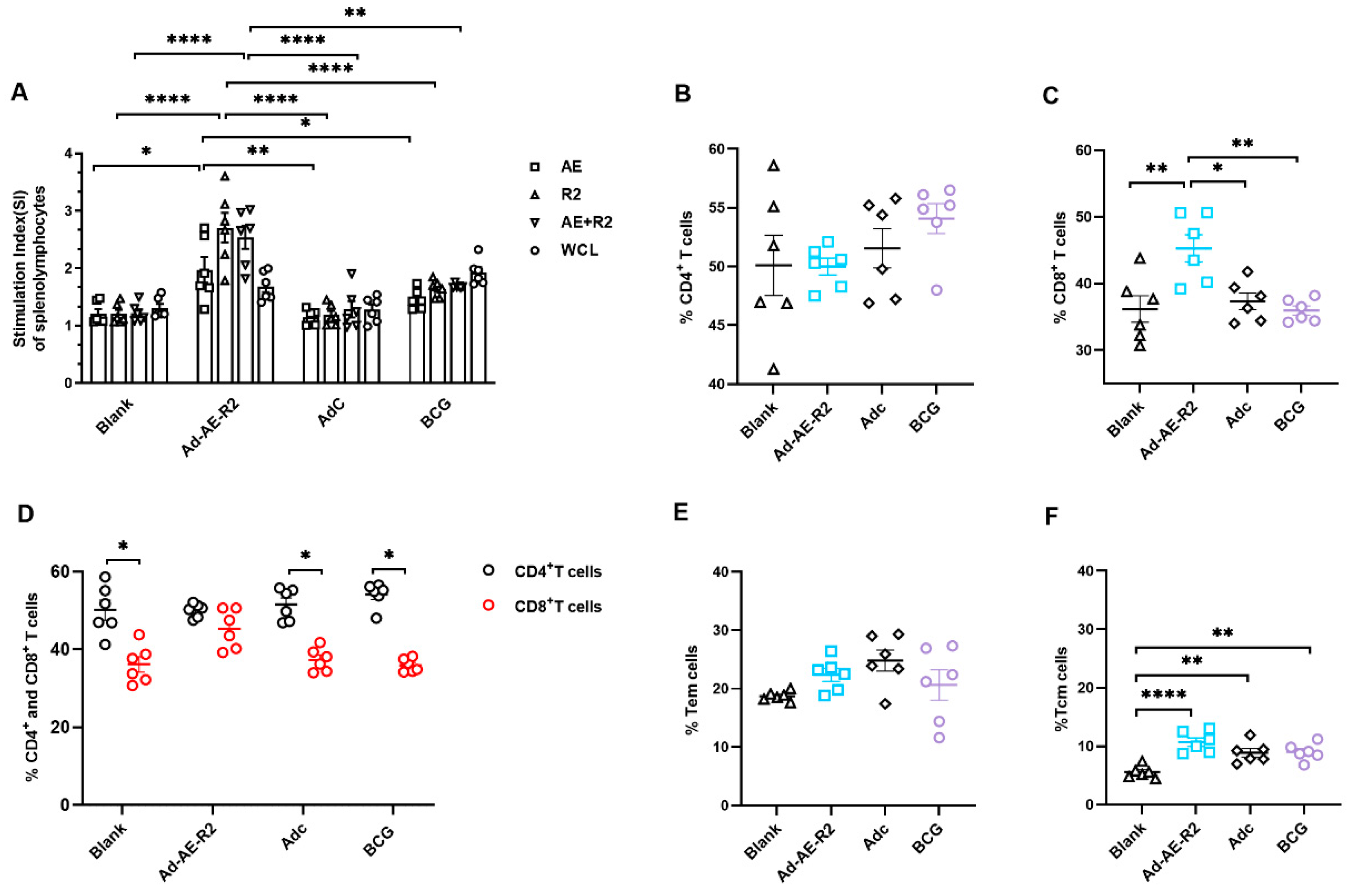
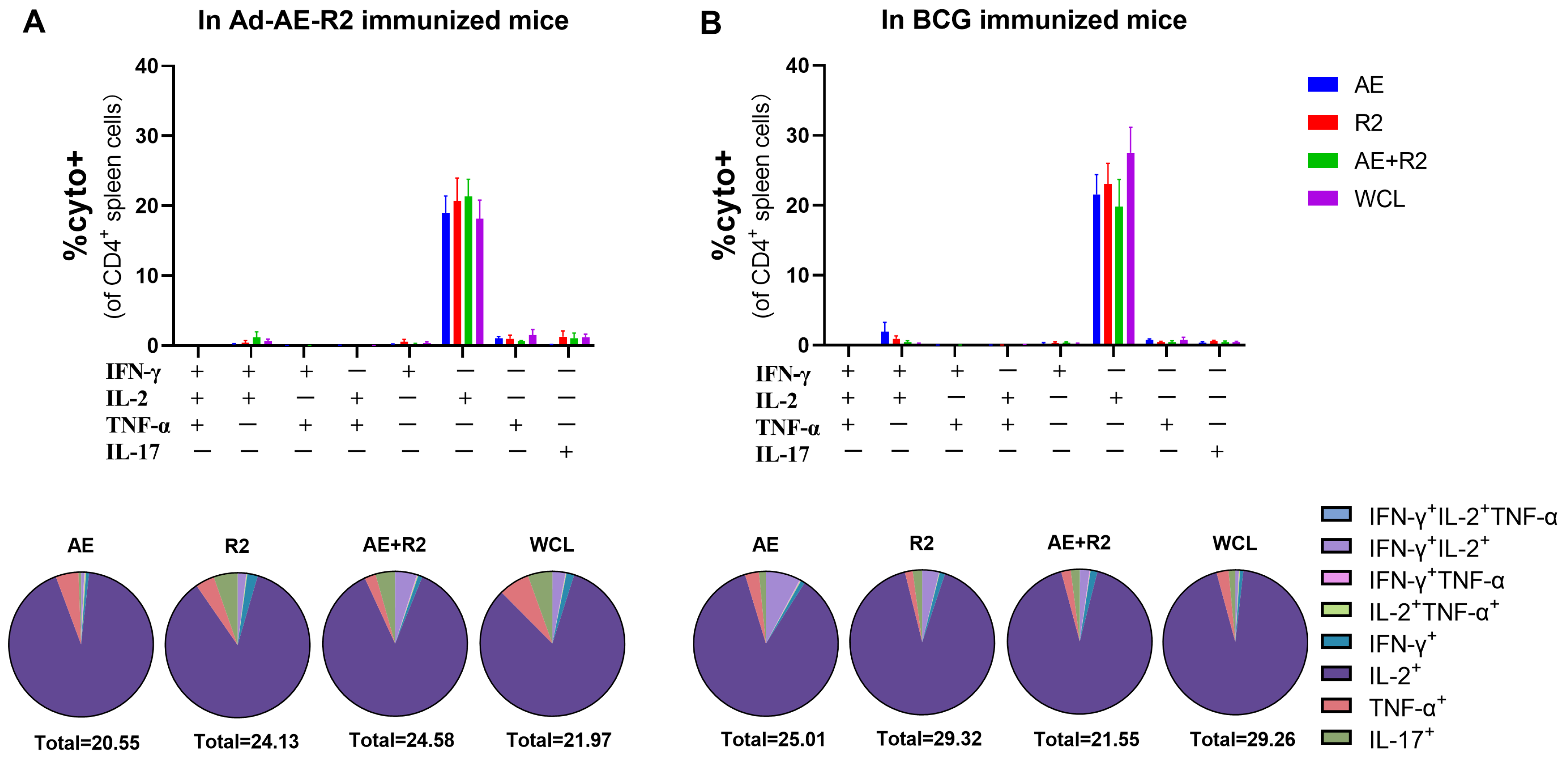

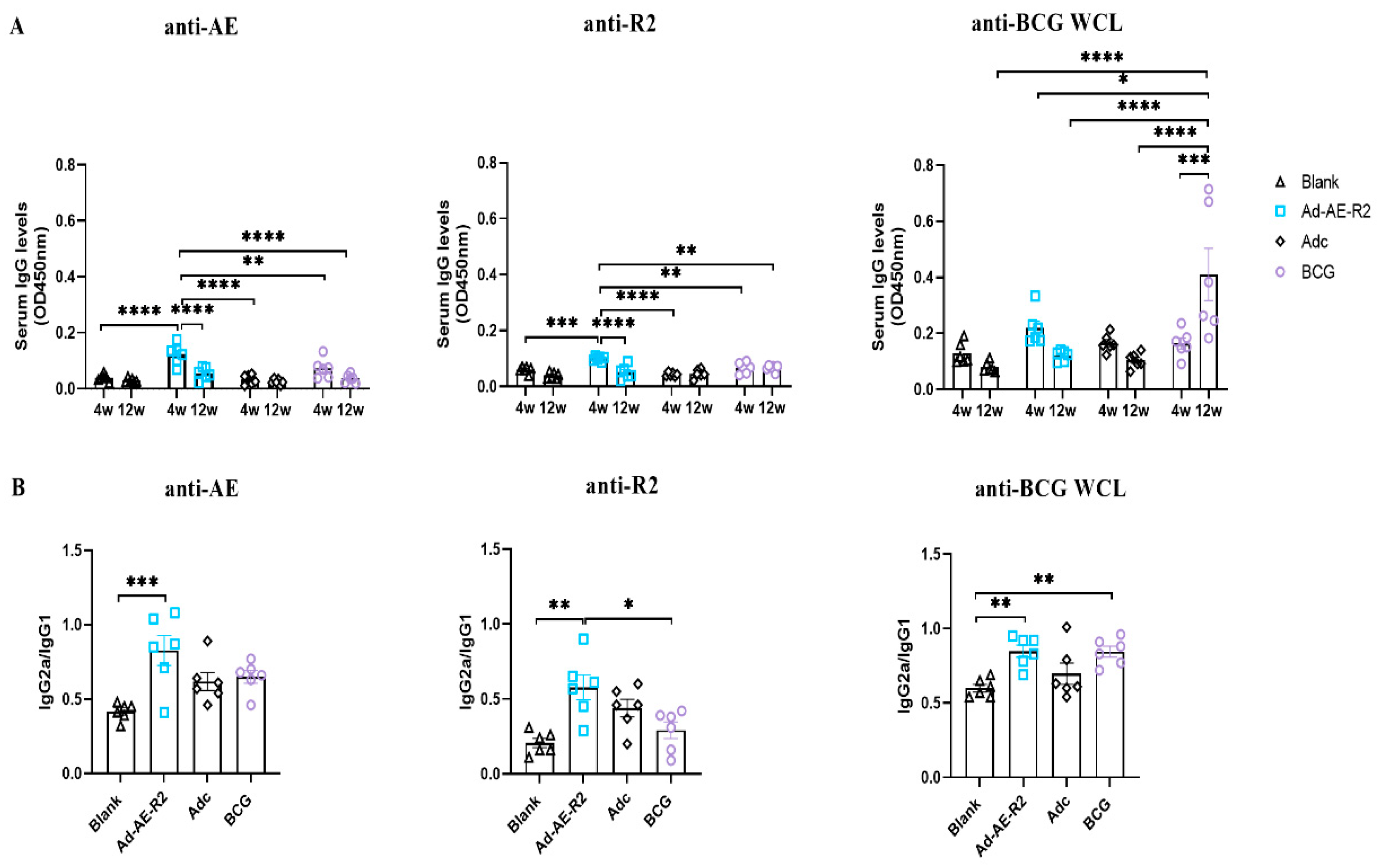
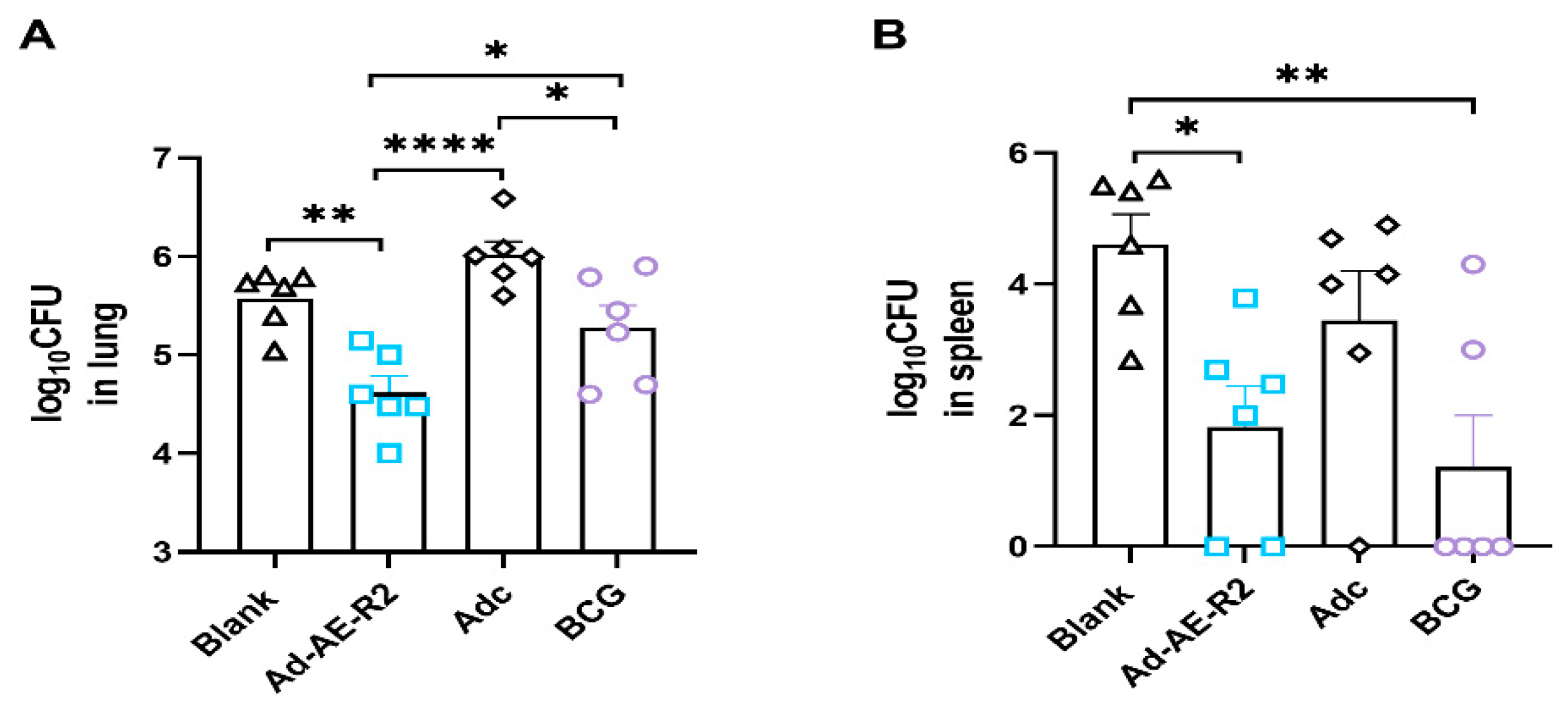
Disclaimer/Publisher’s Note: The statements, opinions and data contained in all publications are solely those of the individual author(s) and contributor(s) and not of MDPI and/or the editor(s). MDPI and/or the editor(s) disclaim responsibility for any injury to people or property resulting from any ideas, methods, instructions or products referred to in the content. |
© 2024 by the authors. Licensee MDPI, Basel, Switzerland. This article is an open access article distributed under the terms and conditions of the Creative Commons Attribution (CC BY) license (https://creativecommons.org/licenses/by/4.0/).
Share and Cite
Wang, L.; Kang, J.; Jiang, H. Intranasal Immunization with a Recombinant Adenovirus Encoding Multi-Stage Antigens of Mycobacterium tuberculosis Preferentially Elicited CD8+ T Cell Immunity and Conferred a Superior Protection in the Lungs of Mice than Bacillus Calmette–Guerin. Vaccines 2024, 12, 1022. https://doi.org/10.3390/vaccines12091022
Wang L, Kang J, Jiang H. Intranasal Immunization with a Recombinant Adenovirus Encoding Multi-Stage Antigens of Mycobacterium tuberculosis Preferentially Elicited CD8+ T Cell Immunity and Conferred a Superior Protection in the Lungs of Mice than Bacillus Calmette–Guerin. Vaccines. 2024; 12(9):1022. https://doi.org/10.3390/vaccines12091022
Chicago/Turabian StyleWang, Limei, Jian Kang, and Hong Jiang. 2024. "Intranasal Immunization with a Recombinant Adenovirus Encoding Multi-Stage Antigens of Mycobacterium tuberculosis Preferentially Elicited CD8+ T Cell Immunity and Conferred a Superior Protection in the Lungs of Mice than Bacillus Calmette–Guerin" Vaccines 12, no. 9: 1022. https://doi.org/10.3390/vaccines12091022




